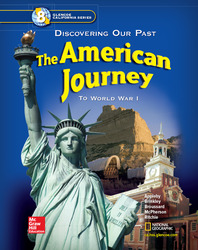Discovering Our Past: The American Journey to World War IChapter 2:
Road to IndependenceWeb Lesson PlansIntroduction
In this chapter students learned about the many events that led to the American Revolution. As anger toward Britain grew, many colonists began to feel that independence was the only option. The members of the Second Continental Congress began to discuss independence in the early summer of 1776. By July they were ready to vote. Even though it was considered treason, and would mean death if they were caught, the vote to declare independence was unanimous.
Lesson Description
Students will visit the History Channel Web site's exhibit about the Declaration of Independence. This site features information on the drafting of the document, the modern preservation efforts, and the biographies of the signers. Students will answer several questions and then be asked to prepare a two-minute presentation about one of the signers of the Declaration of Independence.
Instructional Objectives- The learner will be able to describe the events leading to the vote for independence.
- The learner will be able to summarize the political and philosophical influences on the content of the Declaration of Independence.
- The learner will be able to organize details about the biography of one of the signers of the Declaration of Independence to include in a short presentation.
Student Web Activity Answers- Benjamin Franklin, John Adams, Thomas Jefferson, Roger Sherman, and Robert Livingston
- Jefferson was considered the most eloquent writer.
- Jefferson was familiar with the ideas of the French and English Enlightenments, he was inspired by the writings of John Locke, and also used many ideas from his own draft of the Virginia state constitution and George Mason's Virginia Declaration of Rights.
- The first modern preservation efforts began in 1951. The document was sealed in a bronze, bullet-proof glass case at the National Archives. The damaging oxygen was replaced with humidified helium, which blocks oxygen and other irritants, and a filter was added to screen out harmful light. In 2003, it was stored in a case made from commercially pure titanium, filled with inert argon gas.
- Students' presentations will vary, but should be factually accurate.
 | 






